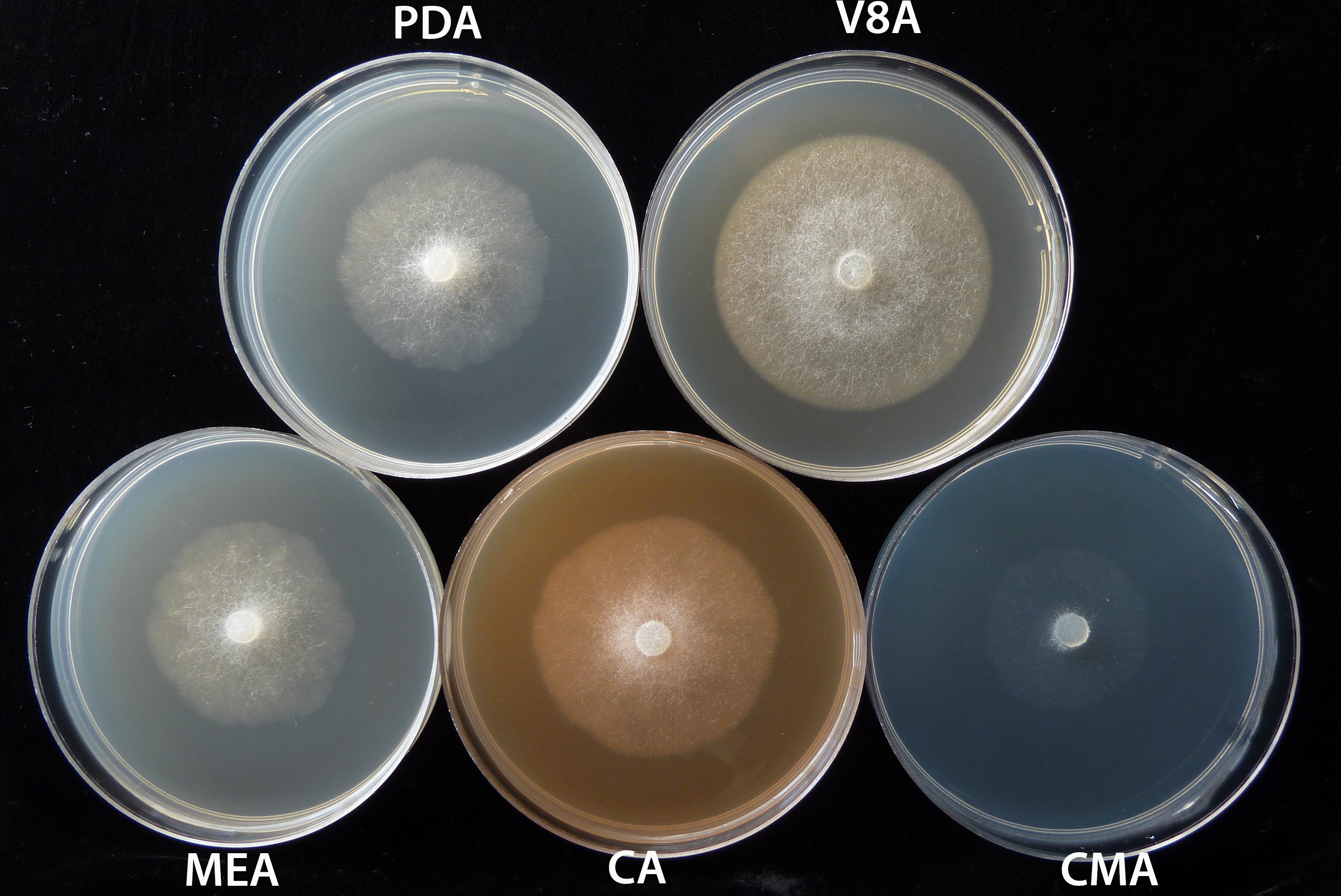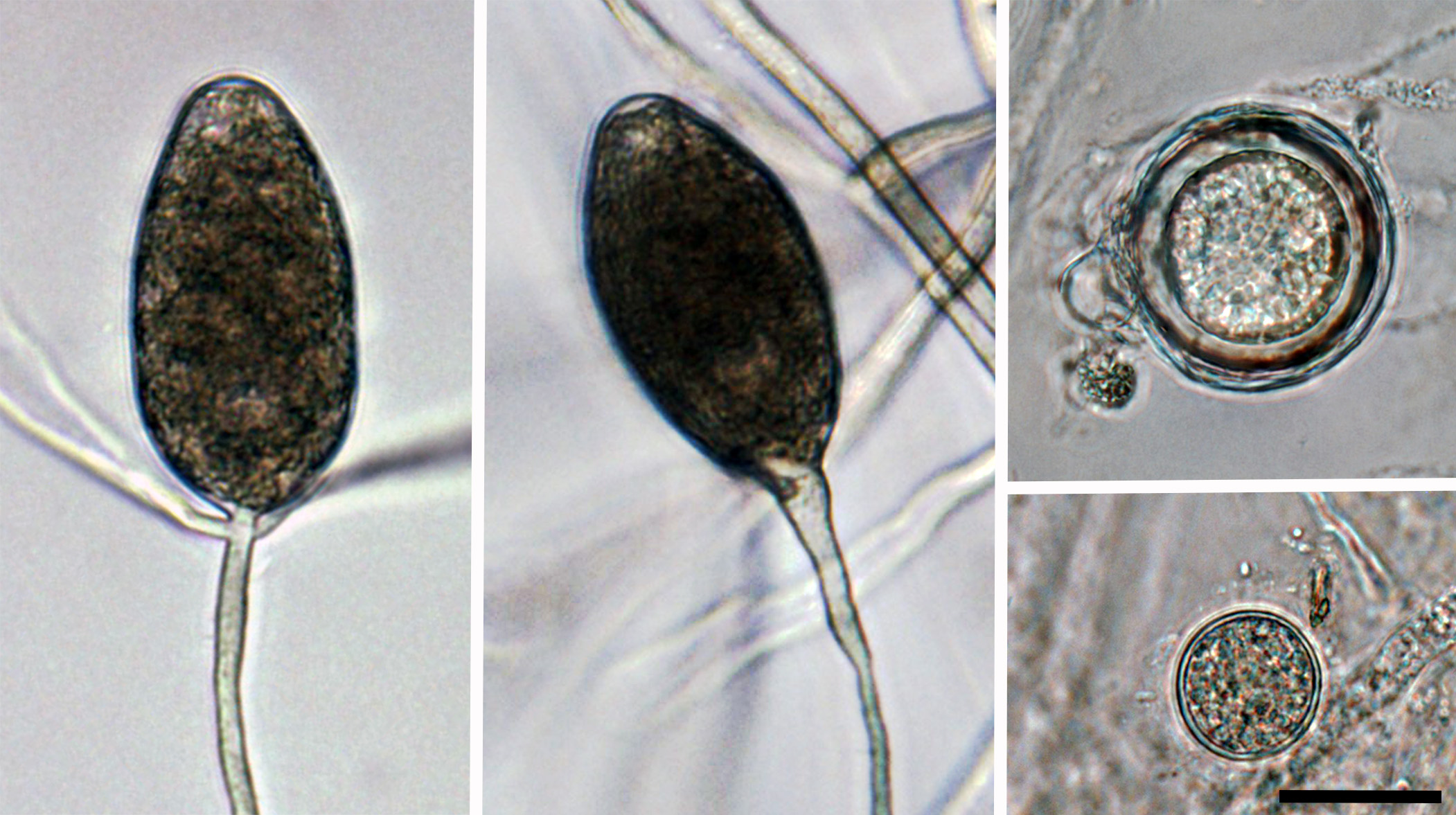Phytophthora aquae-cooljarloo
|
Phytophthora spp. in subclade 6a: portion of the seven-loci ML phylogeny featuring the type cultures of 212 described species (by T. Bourret). Notice the position of P. aquae-cooljarloo Ex-type CBS 146550. Gloria Abad, USDA S&T.
|
|
Phytophthora spp. in subclade 6a: Morphological Tabular key (PDF) and Tabular key legends (PDF) in IDphy2 KEY SECTION. Notice the data of P. aquae-cooljarloo Ex-type CBS 146550. Gloria Abad, USDA S&T.
|
|
colony morphology after 7 d growth at 20ºC on PDA, V8A, MEA, CA, and CMA |
|
typical persistent, non-papillate, ellipsoid and limoniform sporangia; aplerotic oogonia with paragynous antheridia; small chlamydospore; scale bar = 20µm |
Name and publication
Phytophthora aquae-cooljarloo Mostowf. & T.I. Burgess (2020)
Mostowfizadeh-Ghalamfarsa R, Burgess TI. 2020. Phytophthora aquae-cooljarloo. Fungal Planet 1167. in Crous et al. Fungal Planet Description Sheets 1284–1382. Persoonia 45: 241–409
Corresponding authors: rmostowfi@shirazu.ac.ir; tburgess@murdoch.edu.au
Nomenclature
Mycobank
Etymology
named for the association of this species with water at the place Cooljarloo
Typification
Type: AUSTRALIA, Western Australia, Cooljarloo, baited from pond water, 20 Sept. 2017, holotype MURU484
Ex-type: culture CBS 146550 = VHS36940
Sequences for ex-type in original manuscript: ITS MT210484, β-tubulin MT210475, HSP90 MT210480, cox1 MT210466, nadh1 MT210470, LSU MT210485
Ex-type in other collections
(ET) CBS 146550, VHS36940, AUS6D
Molecular identification
Voucher sequences for barcoding genes (ITS rDNA and COI) of the ex-type (see Molecular protocols page)
Phytophthora aquae-cooljarloo ITS rDNA, COI
Voucher sequences for Molecular Toolbox with seven genes (ITS, β-tub, COI, EF1α, HSP90, L10, and YPT1
(see Molecular protocols page) (In Progress)
Voucher sequences for Metabarcoding High-throughput Sequencing (HTS) Technologies [Molecular Operational Taxonomic Unit (MOTU)]
(see Molecular protocols page) (In Progress)
Sequences with multiple genes for ex-type in other sources
- NCBI: Phytophthora aquae-cooljarloo
- EPPO-Q-bank: Phytophthora aquae-cooljarloo
- BOLDSYSTEMS: Phytophthora aquae-cooljarloo
Position in multigenic phylogeny with 7 genes (ITS, β-tub, COI, EF1α, HSP90, L10, and YPT1)
Clade clade:
a taxonomic group of organisms classified together on the basis of homologous features traced to a common ancestor
6a
Morphological identification
Colonies and cardinal temperatures
Colony colony:
assemblage of hyphae which usually develops form a single source and grows in a coordinated way
morphology on CA, V8A, and MEA was uniform, rosaceous pattern observed on PDA. Minimum growth temperature 4°C, optimum 30°C, and maximum 35°C.
Conditions for growth and sporulation
SporangiaSporangia:
sac within which zoospores form, especially when water is cooled to about 10°C below ambient temperature; in solid substrates, sporangia usually germinate by germ tubes
are produced in water cultures (soil extract or river water) and not observed in solid media. OogoniaOogonia:
the female gametangium in which the oospore forms after fertilization by the antheridium
are formed readily in single-strain culture on CA and V8 after about 14 d.
Asexual phase
SporangiaSporangia:
sac within which zoospores form, especially when water is cooled to about 10°C below ambient temperature; in solid substrates, sporangia usually germinate by germ tubes
were non-papillate, persistentpersistent:
pertaining to sporangia that remain attached to the sporangiophore and do not separate or detach easily (cf. caducous)
, and predominantly ellipsoidellipsoid:
refers to a solid body that forms an ellipse in the longitudinal plane and a circle in cross section; many fungal spores are ellipsoidal or elliptic
to ovoidovoid:
egg-shaped, with the widest part at the base of the sporangium and the narrow part at the apex
in shape with internal proliferationinternal proliferation:
internal proliferation occurs when the sporangiophore continues to grow through an empty sporangium
, both nested and extended. SporangiaSporangia:
sac within which zoospores form, especially when water is cooled to about 10°C below ambient temperature; in solid substrates, sporangia usually germinate by germ tubes
averaged 66 x 37 µm (overall range 38–101 x 29–54 µm).Sporangiophores simple. Hyphal swellings absent. ChlamydosporesChlamydospores:
an asexual spore with a thickened inner wall that is delimited from the mycelium by a septum; may be terminal or intercalary, and survives for long periods in soil
present.
Sexual phase
Homothallic. OogoniaOogonia:
the female gametangium in which the oospore forms after fertilization by the antheridium
had smooth walls and size ranged from 23–47 µm. OosporesOospores:
zygote or thick-walled spore that forms within the oogonium after fertilization by the antheridium; may be long-lived
apleroticaplerotic:
pertaining to a mature oospore that does not fill the oogonium; i.e. there is room left between the oospore wall and oogonium wall (cf. plerotic)
, globoseglobose:
having a rounded form resembling that of a sphere
, and golden brown on maturity, size ranged 19–41 µm. AntheridiaAntheridia:
the male gametangium; a multinucleate, swollen hyphal tip affixed firmly to the wall of the female gametangium (the oogonium)
paragynousparagynous:
pertaining to the sexual stage in which the antheridium is attached to the side of the oogonium (cf. amphigynous)
.
Most typical characters
Phytophthora aquae-cooljarloo has similar morphology to related species in cladeclade:
a taxonomic group of organisms classified together on the basis of homologous features traced to a common ancestor
6a.
Specimen(s) evaluated
Australia, Western Australia, Cooljarloo, baited from pond water, 2017, CBS 146550; 2019, VHS39966; 1996, HSA2304
Hosts and distribution
Distribution: Australia
Substrate: water
Disease: no known disease
Additional references and links
- SMML USDA-ARS: Phytophthora aquae-cooljarlo
- EPPO Global Database: Phytophthora aquae-cooljarlo
- Forest Phytophthoras of the World: Phytophthora aquae-cooljarlo
- CABI Digital Library: Phytophthora aquae-cooljarlo
- Encyclopedia of Life (EOL): Phytophthora aquae-cooljarlo
- Index Fungorum (IF): Phytophthora aquae-cooljarlo
Fact sheet author
Treena Burgess, Ph.D., Phytophthora Science and Management, Harry Butler Institute, Murdoch University, Australia
Z. Gloria Abad, Ph.D., USDA-APHIS-PPQ-S&T Plant Pathogen Confirmatory Diagnostics Laboratory (PPCDL), United States of America.



